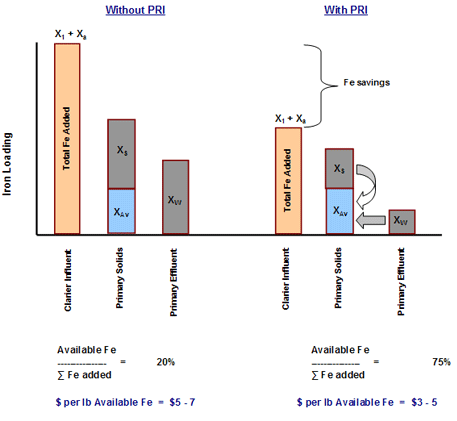PRI-CEPT® Phosphorus Removal from Wastewater
Example 2.
Chemical phosphorus removal from wastewater and/or CEPT removal from
wastewater using hydrogen peroxide regenerated iron
When applied to plant influents, hydrogen peroxide destroys dissolved and/or total sulfide that otherwise scavenges Fe3+
added for CEPT and/or chemical phosphorus removal from wastewater. The
foundational aspect of this PRI-TECH application is that one lb of
total sulfide theoretically consumes 3.5 lbs Fe3+ and thus represents an additional cost of $2 - 3 per lb influent sulfide.
2 HS- + 2 FeCl3 → So + FeS + Fe2+ + 2 H+ + 6 Cl- |
FeS + 2 FeCl3 → So 3 Fe2+ + 6 Cl- |
On
the other hand, pre-oxidizing one lb of influent sulfide with hydrogen
peroxide (as commonly done for headworks odor control) typically
requires 1.2 - 1.5 lbs hydrogen peroxide and so represents a cost of
$0.75 - 1.25 per lb influent sulfide. For a 10 MGD plant with 3.0 mg/L
influent sulfide, this difference could produce savings of around
$150,000 per yr, with the unavoidable side-benefit that odor control is
improved (i.e., less dissolved sulfide in the clarifier
influent/effluent).
An important secondary benefit of adding Fe
to primary clarification is that the Fe captured into the settled solids
goes to anaerobic digesters where it can control biogas H2S
and struvite scaling. Consequently, it is important that the PRI
technology not deprive the digesters of this needed Fe. Key in this
regard is the form in which the Fe is delivered to the digesters, and in
particular, the ‘availability' of that Fe to provide benefit. The
diagram below illustrates the partitioning of Fe through primary
clarification under two scenarios: if influent sulfide present and
allowed to consume Fe3+; and if influent sulfide is pre-oxidized by hydrogen peroxide (before Fe3+ addition).


An important and under-appreciated aspect in these figures is that Fe
flowing over the primary weirs is incorporated into the secondary
biomass. Because most of this biomass passes through anaerobic
digestion, that Fe is less available to control biogas H2S
levels and struvite scaling. The effect of PRI-TECH™ application is
thus to increase the capture of Fe into the primary settled solids, and
in a form that's available to provide digester benefits.
Back to top
Get More Information
Contact USP Technologies for more information on our products and services: